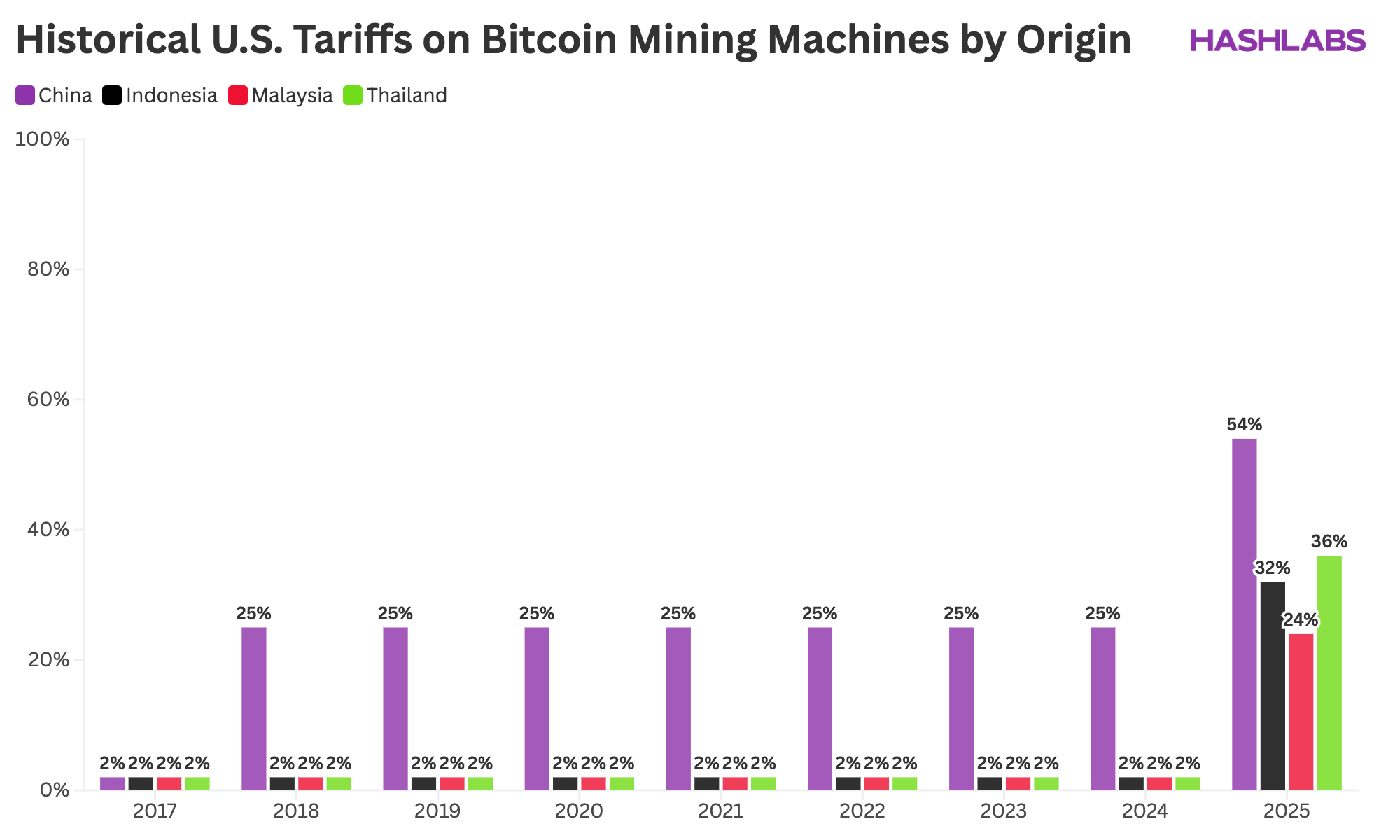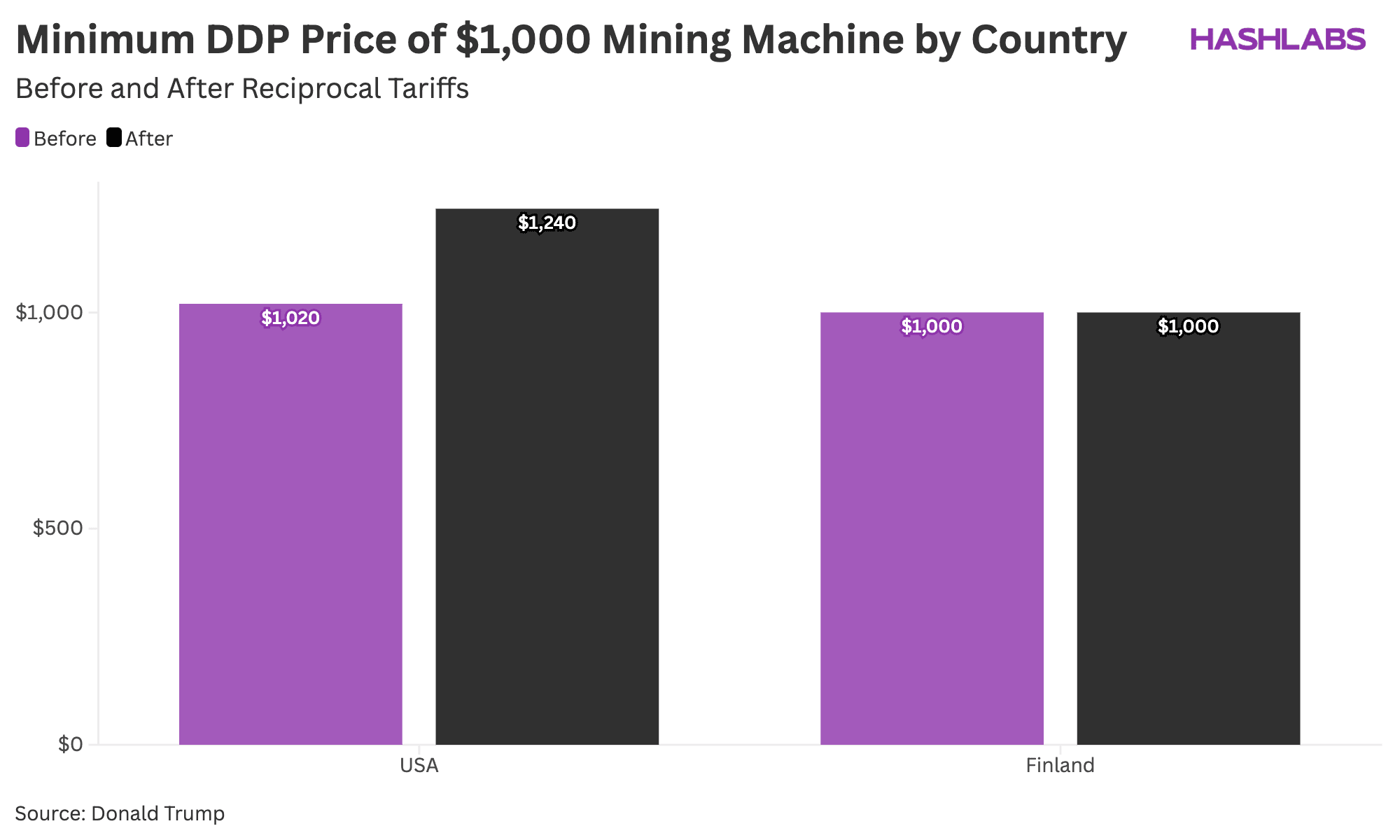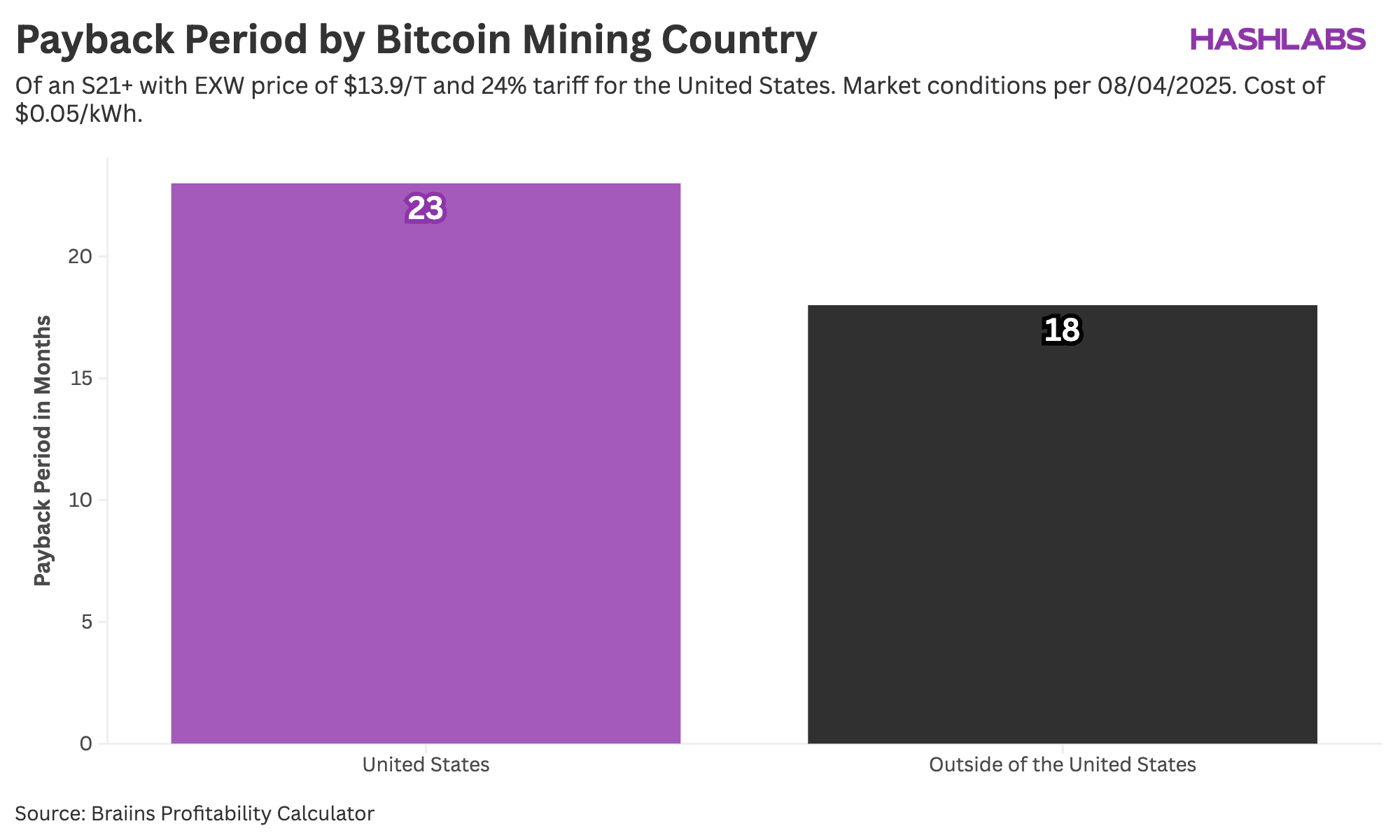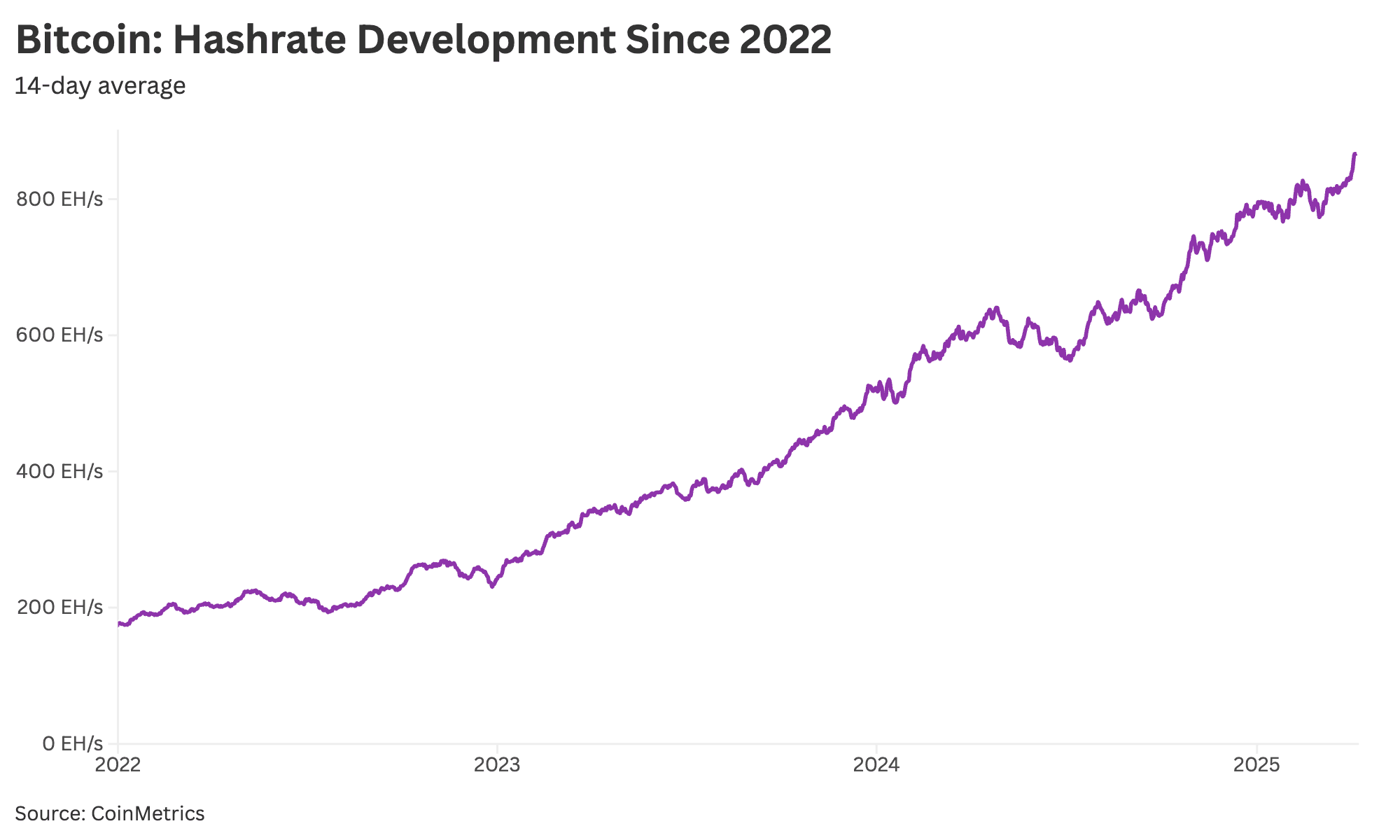How Trump’s Tariffs Will Affect Bitcoin Mining
Jaran Mellerud
On April 2nd, Donald Trump announced sweeping new tariffs on imported goods, aiming to strengthen the U.S. trade balance. Southeast Asia was among the most brutally hit, with far-reaching consequences for the bitcoin mining machine supply chain. This region is home to most machine manufacturing, including key producers like Bitmain, MicroBT, and Canaan.
Additionally, with the U.S. accounting for a significant 36% https://data.hashrateindex.com/network-data/global-hashrate-heatmap of global hashrate, the tariffs could severely impact miner economics, hardware prices both in the U.S. and internationally, and the global hashrate distribution.
Before diving into the various ways these tariffs are expected to impact the bitcoin mining industry, it is important to first provide a brief explanation of how the tariffs function.
How tariffs work
Tariffs are taxes imposed by a government on imported goods. Their purpose is often to protect domestic industries by making foreign products more expensive. When a tariff is applied, the importer must pay a percentage of the product’s declared value to customs upon entry.
For example, if a U.S. company imports $1,000 worth of electronics from China and the tariff rate is 54%, the importer must pay an additional $540 in tariffs, bringing the total importation cost to $1,540. This increased cost is often passed on to consumers or reduces the importer’s profit margin.
Tariff history: The U.S.–China trade war and its ripple effects
Bitcoin mining is a global industry, with a significant concentration in the U.S., and has already been impacted by the trade war and the resulting tariffs. However, historically, the industry has found ways to circumvent these tariffs. In the following section, we will explore how tariffs have historically influenced the bitcoin mining supply chain and the strategies used to avoid them.
In 2018, the U.S. government imposed a 25% tariff on a wide range of Chinese goods, including electronics, as part of a broader trade war with China.
In response, Bitmain and similar firms sought ways to circumvent these steep tariffs. They began shifting their production from mainland China to Southeast Asian countries such as Indonesia, Thailand, and Malaysia, where goods exported to the U.S. were tariff-free or subject to much lower duties — typically ranging from 1% to 3% for electronics.

This strategy was effective until earlier this month when Trump raised tariffs on goods imported from Indonesia, Malaysia, and Thailand to 32%, 24%, and 36%, respectively. As a result, both Bitmain and MicroBT can no longer entirely avoid these high tariffs, which were initially only applied to imports from China.
In the following sections, we will explain how the recently implemented tariffs will affect the bitcoin mining industry.
Machines will become much more expensive in the US
The most immediate and obvious impact of the tariffs is a significant increase in machine prices in the U.S.
As noted by Ethan Vera on The Mining Pod https://www.youtube.com/watch?v=hCawL5OuDSc , “... any company that operates in the U.S. that is looking to acquire machines is going to have to pay somewhere between 22% and 36% more for that machine.” This aligns with our data.
However, the 22% price increase applies only to imported machines. There is still a considerable stock of machines available in the U.S. Currently, based on Bitmars' pricing, there’s a 13% to 25% price difference between machines in the U.S. and those in Hong Kong. As the U.S. stock is depleted, this gap will likely close to 22%, plus a small shipping fee.

The illustration above shows the final imported cost of a bitcoin mining machine that initially cost $1,000 before import to the United States and Finland, both before and after the introduction of reciprocal tariffs. Finland, like most other countries, have no import tariffs on electronics from Asia - we use that country as an example since we are mining there.
As shown, the cost was initially slightly higher for importing a machine to the U.S., due to a tariff of approximately 2%. However, after the additional tariffs were introduced, a machine that originally cost $1,000 now costs a minimum of $1,240 in the U.S. That’s a significant increase. Meanwhile, in Finland and most other countries, there are no tariffs, so the cost of a $1,000 machine remains unchanged.
In an industry as cost-sensitive as Bitcoin mining, a 22% price increase on machines can make operations financially unsustainable. Later in this article, we will explore how these changes will impact the profitability of mining in the U.S. compared to the rest of the world.
Machines might become cheaper outside of the US
As machine prices rise in the U.S., they could paradoxically decrease in the rest of the world.
The demand for shipping machines to the U.S. is set to plummet, likely nearing zero. Given that the U.S. has been the dominant player in the ASIC market, accounting for nearly 40% of the global hashrate, this sharp decline in U.S. purchasing will cause a significant reduction in global demand.
With lower demand from U.S. miners, manufacturers will be left with excess stock originally intended for the U.S. market. To offload this surplus, they’ll likely need to lower prices to attract buyers in other regions.
While it's difficult to predict exactly how much machine prices will fall—since mining profitability also plays a role—we can confidently say that, based on basic economic principles, a decrease in demand for an asset typically leads to a drop in its price.
This price reduction will make it easier for miners outside the U.S. to continue expanding, which, as we’ll explain next, is likely to decrease the U.S.'s share of the global hashrate.
The US share of the global bitcoin mining industry will decline
The United States has been the dominant force in bitcoin mining since China’s mining ban in 2021. Today, the U.S. accounts for roughly 36% of the global hashrate, according to Hashrate Index.
Like any business, bitcoin mining hinges on balancing risk and reward. The U.S. has attracted substantial mining investment over the past four years because it’s been seen as one of the least risky environments in the world, offering political stability, abundant energy, and deregulated power markets. In addition, miners have so far avoided major import tariffs, helping them keep capital expenditures under control. Together, these factors have created an unbeatable risk-reward profile.
To understand how the new tariffs could reshape the U.S. share of global mining, we begin by analyzing the reward side of the equation.
The chart below shows the projected payback period for an Antminer S21+ when deployed in the United States versus a country unaffected by tariffs. As the data illustrates, paying 24% more for the same machine in the U.S. dramatically extends the payback period—undermining the core economic case for mining domestically.

As if higher machine costs weren’t enough, the risk side of the equation has also taken a hit. Many U.S. miners initially felt reassured when Trump returned to power, expecting a stable regulatory environment. But they are now experiencing the flip side of his unpredictable policy shifts. Even if these tariffs are rolled back within a few months, the damage is done—confidence in long-term planning has been shaken. Few will feel comfortable making major investments when critical variables can change overnight.
In summary, the once-unmatched risk-reward balance of bitcoin mining in the U.S. has deteriorated significantly. This shift will likely lead to a gradual decline in the U.S.'s share of the global mining industry relative to other countries.
Of course, existing machines already imported into the U.S. will remain unaffected—there’s no reason for miners to unplug them. But the path to expansion is now steep and uncertain.
Meanwhile, miners in tariff-free jurisdictions will continue to scale, reinforcing their competitive advantage. As a result, the U.S. share of global hashrate is expected to decline—not because miners are exiting, but because they are no longer growing.
In the broader picture, this may lead to a more geographically diverse bitcoin mining landscape than ever before. While the U.S. will remain a major player, its dominance will fade, giving rise to a more globally distributed hashrate. This is in line with predictions from Kristian Csepcar from Braiins and Summer Meng from Bitmars. https://cointelegraph.com/news/trump-tariffs-bitcoin-mining-impact
Network hashrate growth will slow
In the previous section, we explained how the U.S. share of the global bitcoin mining industry is set to decline as a result of the new tariffs. Given the U.S.’s significant role in global hashrate, any slowdown—or outright halt—in its growth will inevitably contribute to a broader deceleration in global hashrate expansion.
As of Q2 2025, the U.S. accounts for approximately 36% of global hashrate, according to Hashrate Index. For comparison, CBECI data shows that the U.S. held around 38% in January 2022. This suggests that over the past three years, the U.S. mining sector has grown at roughly the same pace as the rest of the world.
Assuming this growth trajectory would have continued, the U.S. would have contributed approximately 36% of all future global hashrate growth. Therefore, if the U.S. mining industry stalls due to the impact of tariffs, it could result in a reduction of up to 36% in the expected global hashrate growth rate.

However, it is extremely unlikely that the U.S. mining industry will stop growing entirely. As we’ll explain in the next section, these tariffs may be temporary, and there could be ways around them over time. Therefore, it’s more realistic to expect the U.S. mining sector to continue expanding, but at a much slower pace than before. The assumption of a 36% reduction in global hashrate growth should be seen as an absolute upper limit— the actual impact will likely be somewhat lower.
In the longer term, if U.S. growth slows or stalls, miners in other countries will likely ramp up their expansion and gradually fill the gap.
Still, in the short to medium term—over the next year or two—we could see a slower global hashrate growth than previously expected. And in an industry where slower hashrate growth means higher revenue, this would be a welcome development for miners everywhere.
Is this temporary or permanent?
So far in this article, I’ve taken a fairly bearish view on how these tariffs will affect the U.S. bitcoin mining industry—and rightly so, given the immediate and severe impact they’re likely to have. However, the situation is more nuanced, and there are important questions worth exploring.
In the following section, we’ll tackle some of these questions and assess how the long-term outlook for U.S. mining might evolve in response to the current challenges.
Could Trump walk back the tariffs just months after imposing them? Yes, that’s entirely possible—especially given Trump’s unpredictable and often reactive policymaking style. If the tariffs were reversed, U.S. miners would once again be able to import machines at competitive prices, alleviating much of the immediate pressure they’re facing.
However, the damage to long-term investor confidence may already be done. Even if the tariffs are lifted, the fact that they were introduced so abruptly makes it harder to justify large-scale, long-term investments in the U.S. mining industry. In an industry as capital-intensive as bitcoin mining, policy stability is crucial—and right now, that’s in short supply. ** Could machine manufacturers bypass the tariffs by importing chips from Taiwan and assembling the machines in the U.S.?** Machine manufacturers could potentially bypass the tariffs by importing chips from Taiwan and assembling the machines domestically in the U.S. According to the official White House statement https://www.whitehouse.gov/fact-sheets/2025/04/fact-sheet-president-donald-j-trump-declares-national-emergency-to-increase-our-competitive-edge-protect-our-sovereignty-and-strengthen-our-national-and-economic-security/ , semiconductors are not subject to the reciprocal tariffs. This suggests that chips can be imported to the U.S. without incurring the additional costs. However, producing the machines domestically would still require other components, many of which would be more expensive due to the tariffs, contributing to a general inflation in the U.S. economy.
Currently, manufacturers like MicroBT have set up assembly lines in the U.S., but Bitmain has not yet followed suit. Even with MicroBT's assembly capabilities, their production capacity is not nearly enough to meet the U.S. demand for machines in the next 1-2 years.
Thus, while this option is technically possible, it would not solve the immediate problem for U.S. miners. However, in the long-term, we expect more machine assembly to gradually move to the U.S. as manufacturers adjust to the new tariff environment and scale up production capacity domestically. This shift could help reduce reliance on international imports and lower the impact of tariffs over time.
**Is it even realistic to build an entire bitcoin mining hardware supply chain in the U.S.—from chip fabrication to final assembly? **Building an entire bitcoin mining hardware supply chain in the U.S.—from chip fabrication to final assembly—is a complex challenge, even though there is strong momentum from both the bitcoin mining industry and political leaders pushing for onshoring chip production. Currently, the most advanced chips used in bitcoin mining are produced in Taiwan and South Korea, where decades of expertise and a finely-tuned supply chain have been developed. This reliance on Asian countries for critical components is a significant geopolitical risk for the U.S., not just in bitcoin mining but across various high-tech industries.
While it's feasible for the U.S. to onshore the assembly of machines, the major hurdle is the continued dependence on imported chips. Companies like Bitmain, MicroBT, and Canaan could set up assembly lines in the U.S., and new players like Auradine are eyeing the market too. However, without local access to cutting-edge chips, these manufacturers will still rely on imports for the foreseeable future.
Kristian Csepcsar from Braiins highlights the challenge further, saying, “Foundries are already setting up chip-making facilities in the U.S., but they start at high nanometers. It will take years to develop the talent pool and expertise to move to lower nanometers. The process is gradual—companies start with high-nanometer chips to make the investment profitable, then work on scaling up to more advanced technologies. Even if the U.S. moves forward, building a complete, domestic bitcoin mining hardware supply chain is nearly impossible at that scale, and the cost would be extremely high. The real question is whether it would still be cheaper to manufacture in China and pay tariffs if the demand is high. After all, spinning up end-to-end manufacturing in the U.S. takes time and considerable investment, much like Bitmain's recent attempts to create an assembly line in China—although nothing much has been heard since then.”
In short, while there is significant potential for U.S.-based assembly and chip-making over time, a fully domestic supply chain for bitcoin mining hardware remains a long-term goal, not a short-term reality. The cost, time, and complexity of this transition make it unlikely to happen at scale in the next few years.
Conclusion
In conclusion, while the new tariffs on imported goods are set to significantly impact the U.S. bitcoin mining industry—leading to higher hardware prices, a decline in U.S. market share, and a slowdown in global hashrate growth—the long-term implications are more complex.
As the situation evolves, miners and industry stakeholders will need to closely monitor the political and economic landscape for potential shifts in tariffs and policies. The U.S. mining sector may face challenges in the short term, but there are still opportunities for growth and adaptation in the global mining ecosystem.
If you want to stay informed and navigate the evolving landscape of bitcoin mining, subscribe to our educational newsletter for the latest insights, industry trends, and expert analysis directly in your inbox.
Disclaimer: The content of this article solely reflects the author's opinion and does not represent the platform in any capacity. This article is not intended to serve as a reference for making investment decisions.
You may also like
Hassett: Trump is studying whether "removing Powell" is an option
Strategy returns surpass Nvidia, Tesla, Google, Apple and Microsoft
Polygon and Jio bring blockchain to 450 million users in India

Algorand Foundation and The Core Launch ‘Build on Blockchain’ Series for Industry Leaders

